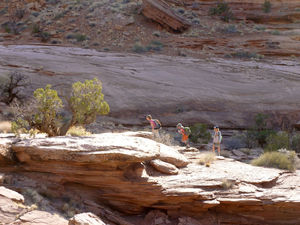Our Public Lands Are More Than Easy Money
 In the spring of 1991 I headed south to Utah to work my first canyon hiking course for the National Outdoor Leadership School.
In the spring of 1991 I headed south to Utah to work my first canyon hiking course for the National Outdoor Leadership School.
I left Lander in a snowstorm with visions of sun-warmed slickrock, ancient ruins tucked in under overhangs, towering salmon-colored canyon walls and shorts dancing in my head. The bus dropped us off near Comb Ridge in Utah’s southeastern corner, and we started hiking. I wore every layer I had. Snow covered the high country, and we sometimes found ourselves crawling to move forward because the sugary facets beneath our feet would not support our weight. Our food supplies ran low, and we began making soups out of whatever we found in our ration bags: broth made from dried onions with flakes of rehydrated peppers was the tastiest concoction we devised.
I never wore shorts or experienced sun-warmed slickrock on that course. My main memory is of postholing past the Bears Ears as we abandoned our route for lower ground and less snow. But I saw some of the most spectacular country I had ever seen, and, despite my discomfort on that particular journey, it was the first of many I worked for NOLS or experienced on my own as the magic of the red rock country pulled me back every spring and fall.
On Dec. 28 President Obama designated the Bears Ears National Monument to protect this part of Utah. With that proclamation he preserved 1.35 million acres of rugged country from future development. The national monument encompasses many of the places I tramped with my backpack for 25-plus years, and I’m glad to hear it will be protected, unless, of course, the new administration tries to undo Obama’s decree.
Read the full story here.
Topics:

